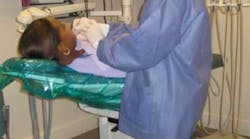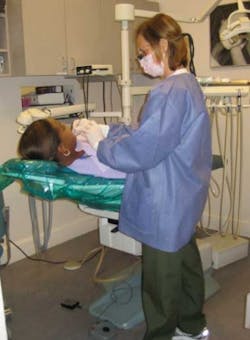by Juli Kagan, RDH, MEd, and Lynn Pencek, RDH, MS
When you were a little kid, did you ever get scolded for tipping forward in your chair, or worse, tipping backward and teetering on two hind legs?
At the time you didn't think about your posture or biomechanics. Fortunately, your body knew it needed to be in a neutral spine-opening position with the hip joint while leaning forward, and needed to lengthen the spine while hinging back. You were forced to sit in those hard wooden chairs and consequently, you often squirmed, daydreamed, or became inattentive. But mostly your body wasn't happy. To counteract this frustration, you fidgeted.
Sitting for long periods of time while leaning forward toward patients and performing repetitive motions (e.g., scaling), builds the front of the body, making these muscles short and tight while the opposing back muscles overstretch, making them long and weak. More importantly, a slumped spine and upper body impairs breathing by closing down the chest, lungs, and diaphragm.
We live in a seated society. But here's the question: Why do you sit to do clinical hygiene? Take a moment and think about it. Is it because someone told you to? Is it because that's what others do? How many of us never even give it a thought? Well, now is the time to consider taking a stand, literally.
Standing has two very important and favorable features. First, when you sit, the intervertebral disc pressure is twice as high compared to standing. This is because, even when sitting up, the vulnerable lumbar region loses its protective natural curve. Secondly, when you move from standing to sitting, the pelvis actually rotates backward, posteriorly, flattening the lower lumbar spine by at least 30 degrees.
Standing takes more muscular energy (a great thing for burning more calories) but can reduce blood supply to the loaded muscles (not such a good thing if you have weak leg veins). To combat this potential problem, keep moving! Try to sit for the maxilla and stand for the mandible. Consider root planing for 45 minutes while standing, then sitting for the next patient. Vary your movements and avoid extreme bending, stretching, and twisting, just as you would while seated.
Standing while working often provides an opportunity to employ direct vision, thus preventing unnecessary leaning and twisting. In addition, the use of extraoral fulcrums can sometimes be used, which provides added stability and leverage.
What is vitally important about standing is that your neck and spine are not compromised. You should NOT lean over the patient to obtain a better view. This can strain the neck as well as upper back muscles. On top of that (pun intended), your shoulders should be in alignment with your body and your forearms should be parallel with the floor, allowing the elbows to rest close to or on your body for support.
Even while seated, it is common for an operator, who has an innate desire to perform the best work possible, to involuntarily lean forward to bring the eyes closer to the viewing area to gain visual acuity. Loupes provide a longer working distance, thus preventing the practitioner from having to lean forward and get into awkward postures.
Whether standing or sitting, the operator's working distance should be the same when a patient is positioned correctly. Dental loupes help maintain this proper posture. Properly fitted dental loupes should have a working distance long enough for the operator to sit up straight, with the shoulders and neck in a healthy posture, while providing enough depth of field to see both maxillary and mandibular teeth without readjusting posture to accommodate for better vision.
Dental loupes should also have a steep optical declination to allow the eyes to look down without bending the neck forward. Otherwise, this precarious and compromised neck position takes the approximate 13-pound unsupported weight of the head forward, which leads to muscle strain. Imagine a big bowling ball-size black pearl necklace, hanging like a dead weight off the center of your shoulders. Try to hold it there for eight hours. This is exactly what happens when you crane your neck anteriorly over the sternum/centerline of your body. Try to keep your neck aligned and neutral as much as possible.
Finally, while standing in the dental operatory to work, bring the chair base ALL the way up. While working on the mandible, bring the headrest/backrest up so the patient's chin is as parallel to the floor as possible.
If you are taller than average and your chair doesn't go up high enough to counter this effect, standing may not be an alternative for you. However, the patient's size may also make a difference. Be aware of both conditions.
Are you still unsure about sitting less? Consider a recent study regarding standing for your health. Researchers discovered that people who sit for long periods of time who were highly inactive had decreased metabolic activity despite daily hour-long exercise programs. There is a large amount of energy associated with standing every day that cannot be compensated for with 30 to 60 minutes in the gym. Finally and most profoundly, researchers are concerned that the average nonexercising people may become even more metabolically unfit if they sit too much.
So go ahead and just do it: Take a stand!
Devoted to life-long learning, dentistry and wellness, as well as physical and mental fitness, Juli Kagan, RDH, MEd, is responsible for the online course, Education for Health Care Professionals (BHSc), plus the ergonomics lectures and clinical instruction in the perio department at Nova Southeastern University. Passionate about Pilates and posture, she is a professional speaker and writer. Juli authored "Mind Your Body: Pilates for the Seated Professional." Visit her Web site at JuliKagan.com for speaking engagements for your local society, state association, or private practice.
Lynn Pencek, RDH, MS, is a senior regional manager for Orascoptic. Since 1993 she has published and presented on the topics of ergonomics, posture, vision, and use of loupes. Lynn has presented at RDH Under one Roof and serves on the corporate advisory board for Dimensions in Dental Hygiene as an expert in magnification, coaxial illumination, and ergonomics. Before her career with Orascoptic, Lynn served as the past president of the Philadelphia Dental Hygiene Association and is a former delegate for the Pennsylvania Dental Hygiene Association. She has worked clinically as a dental hygienist for 12 years and served as part-time clinical faculty at Thomas Jefferson University.
Past RDH Issues







